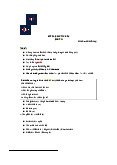



Preview text:
POWERPOINT: How college students can start investing & making money 1. Definition:
Investing is putting your money into different assets such as stocks, bonds, mutual funds,
cryptocurrency, NFTs, etc. There are a lot of ways to invest! But the goal is always the same: to grow your money.
In finance, an investment is a financial asset bought with the idea that the asset will provide
income further or will later be sold at a higher cost price for a profit.
The funds that you invest will earn dividends and/or interest. If those are automatically
reinvested, those, too, will earn dividends and interest. This process then repeats itself over and over again.
2. Why should we start to invest?
Investing is an effective way to put your money to work and potentially build wealth. Smart
investing may allow your money to outpace inflation and increase in value. The greater growth
potential of investing is primarily due to the power of compounding and the risk-return tradeoff.
The money that your young adults in their investment account can help them pay for college,
buy a home, start a family, travel the world, start a business, and more. Not only does investing
as a young adults prepare financially for the future, but it also helps teach them financial literacy.
3. Although we may view college students as being broke, college can actually be a great time to
start investing. Dabbling in investments during college gives you experience with real-world
money lessons. Also, investing sooner can possibly set you up for larger payouts in the future.
Surprisingly, investing does not require you to have a ton of money upfront. Many brokerages do
not require a minimum investment amount. In fact, you can invest with as little as $5. Investing
minimal amounts at the beginning of your college career could leave you graduating with a small
amount of money. ( khúc này đ t so ể n l ạ i cho n ạ gắắn đ nói nha) ể
Detail Steps for reference:
If you don’t know where to start, just start doing some research. And don’t be afraid to ask for help! 1. Decide how much money y ou have to invest
It’s important to set up a budget, our recommendation for you is to download financial
management app in your phone . Figure out how much money you make (after taxes), and
how much money you have left after paying for basic expenses such as rent, utilities, phone,
cable, food, etc. Figure out how much you like to spend on things like going out, clothes or
entertainment. Then, from what’s left, set aside a portion for savings. 2. Where to s tart investing
You don’t have to do it alone because there are plenty of apps out there to help guide you in
this journey, including Acorns, Betterment, Fidelity, SoFi, Robinhood,TD Ameritrade…Some
allow you to make individual trades in stocks, bonds and mutual funds, and others have you
choose your risk level. And then it automatically invests your money in mutual funds that
match that. So, do some research. Choose one. If you feel like it isn’t working for you or
you’re curious, try another one until you find what’s right for you. There’s no one right or wrong way to invest.
The number-one tip emphasized by all experts: Get educated 3. Know your i nvestment options Savings account.
A savings account is an interest-bearing deposit account held at a bank or other financial
institution. Though these accounts typically pay a modest interest rate, their safety and
reliability make them a great option for parking cash you want available for short-term needs.
Certificates of deposit (CDs). This type of account is similar to a savings account but with a
fixed time period and a higher fixed interest rate (more money). So, the catch is that it locks
you in for a certain time period where you can’t touch that money or else you will face a
penalty (fee). So, it’s a great way to make more money than a typical savings account, but
you want to make sure it’s money you won’t need for anything so that you can drop it there until the time period. Money-market funds:
Money-market funds generate income but are considered extremely-low risk, which means
they also don’t generate a high rate of return. But they are a safe option, letting your money
grow little by little. So, financial advisors will often recommend keeping a certain amount of
your portfolio in a money-market fund for security but not too much.
Stocks. When you buy a stock, you are essentially purchasing one piece of one company. The
shareholder is entitled to own portions of the corporation’s assets and profits depending on
how much of the stock they own. Most stocks are bought and sold on exchanges such as the
Nasdaq or the New York Stock Exchange. But you can purchase them through an app or a broker.
Bonds. In the simplest terms, a bond is a loan from an investor to a borrower such as a
certain company. The company uses the money you “lent it” to fund its necessities.
Meanwhile, the investor receives interest on the investment. Bonds are a key ingredient to
having a balanced portfolio as it can help soften the blow if the stock markets plummet.
Mutual funds. Mutual funds bring together investments from many people and invest that
money in stocks, bonds and other assets. The specific stocks, bonds and assets the money is
invested in are known as the “portfolio.” The criteria for what goes in the portfolio can be
anything from a sector (such as technology or health care) to a risk level (growth vs. value)
or a target date (such as 2030). Mutual funds are managed by a money manager who selects
and changes the assets in the portfolio to try to maximize profits for their investors. Since
there is an expert involved in managing the investments, there are fees involved.
Index Funds. An index fund is also a collection of assets, but they are pegged to a specific
index such as the S&P 500 or Nasdaq. One of the perks of index funds is that they tend to be
lower in cost because they don’t have an expert taking the time to pick stocks or bonds for funds. 4. The k ey is to diversify
The key, experts say, is to diversify, which means have a variety of investments in different
things. Don’t put all of your eggs in one basket. That keeps balance, and if one investment is
going down, another might be holding steady or going up.
It’s OK to get advice from friends when investing, but you need to do your own research and
you need to be diversified. If your friend says buy XYZ stock because it went up for them,
don’t just buy that and leave it at that. It could go down for you. So, if you’re diversified, you have a cushion for that. 5. What will you in vest in?
If you’re going to try your hand at investing in individual stocks or other assets, do your
research and start small. Maybe you want to invest in brands you know, such as Apple or
McDonald’s, or maybe you do some research and see what the pros are recommending.
Janelle Finch, former CNBC intern, recommends finding a product you or your friends love
and looking for trends. Start researching the companies behind those products and trends
and then what analysts are saying about those companies as an investment.
Don’t blindly follow any one expert — consider them like your board of directors. You take
their advice into consideration, do your own homework and make your decisions.
Remember: Only you are the boss of your money. And with that responsibility comes great
power! You could make a lot of money, but you could also lose a lot. So, be smart. Learn as
you go. Remember: No one is perfect. And watch your money grow!




